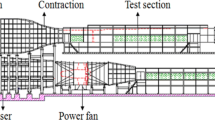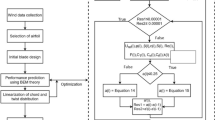Abstract
Blade is an important part in wind turbine system because of its vital role in extraction of energy from wind. In order to extract maximum possible energy, blade should be judiciously designed, for which it is supposed to be divided into several smaller sections (airfoil). SG6043 is selected for this work on account of its few merits over others existing airfoils. The article throws light on basis of blade element momentum theory and adopts its extended form to overcome its limitation in blade design and performance prediction while taking effect of wake into the account. This work investigates the performance of horizontal axis wind turbine (HAWT) in general, with emphasis on small HAWT over wide range of tip-speed ratio considering several effect on wind turbine. Results are validated with other experimental results published in various past literatures.













Similar content being viewed by others
Abbreviations
- WT:
-
Wind turbine
- WECS:
-
Wind energy conversion system
- HAWT:
-
Horizontal axis wind turbine
- \(N_b\) :
-
Number of blades
- \(R_e\) :
-
Reynold number
- \(C_L, C_D\) :
-
Lift and drag coefficient
- \(F_L, F_D\) :
-
Lift and drag force
- \(\alpha\) :
-
Angle of attack
- \(\theta _T\) :
-
Twist angle
- l :
-
Chord length
- \(\theta _p\) :
-
Sectional pitch angle
- \(\lambda\) :
-
Tip speed ratio
- \(C_p\) :
-
Power coefficient
- a :
-
Axial induction factor
- \(a'\) :
-
Angular induction factor
- I :
-
Angle of relative wind/Angle of inclination
- AoA:
-
Angle of attack
- L:D :
-
Lift to drag ratio
References
Burton, T., Sharpe, D., Jenkins, N., Bossanyi, E.: Wind Energy Handbook, pp. 39–311. Wiley Online Library, London (2011)
Mathew, S., Philip, G.S.: Advances in Wind Energy and Conversion Technology. Springer, Berlin (2011)
Devashish, J., Thakur, A.N.: A comprehensive review on wind energy systems for electric power generation: current situation and improved technologies to realize future development. Int. J. Renew. Energy Res. (IJRER), 7, 1786-1805 (2017)
Manwell, J.F., McGowan, J.G., Rogers, A.L.: Wind Energy Explained Theory, Design and Application, pp. 83–139. Wiley, United Kingdom (2009)
Karthikeyan, N., Murugavel, K.K., Kumar, S.A., Rajakumar, S.: Review of aerodynamic developments on small horizontal axis wind turbine blade. Renew. Sustain. Energy Rev. 3, 801–822 (2014)
Gordon Leishman, J.: Aerodynamics of Horizontal Axis Wind Turbines, pp. 1–66. SpringerVerlag, Berlin, Heidelberg (2011)
Wood, D.: Analysis, Small Wind Turbines: Design, and Application, pp. 1–263. Springer, London (2011)
Muhsen, H., Al-Kouz, W., Khan, W.: Small wind turbine blade design and optimization. Symmetry 12, 18 (2020)
Tahir, A., Elgabaili, M., Rajab, Z., Buaossa, N., Khalil, A., Mohamed, F.: Optimization of small wind turbine blades using improved blade element momentum theory. Wind Eng. 43, 299–310 (2019)
Mesquita, A.L.A., Alves, A.S.G.: An improved approach for Performance Prediction of HAWT Using the Strip Theory, pp. 417–430. SAGE Publications Sage UK, London, England (2000)
Mesquita, A., Vaz, J.R.P., Pinho, J.T., Mesquita, A.L.A.: An extension of BEM method applied to horizontal-axis wind turbine design. Renew. Energy 36, 1734–1740 (2011)
Sriti, M.: Improved blade element momentum theory (BEM) for predicting the aerodynamic performances of horizontal Axis wind turbine blade (HAWT). Wind Eng. 38, 191–202 (2018)
Lubitz, W.D.: Impact of ambient turbulence on performance of a small wind turbine. Renew. Energy 61, 69–73 (2014)
Chaudhary, U., Mondal, P., Tripathy, P., Nayak, S.K., Saha, U.K.: Modeling and optimal design of small HAWT blades for analyzing the starting torque behavior. In: Eighteenth National Power Systems Conference (NPSC), IEEE, 1-6 (2014)
Glauert, H.: Airplane Propellers in Aerodynamic Theory, pp. 169–300. Springer Verlag, Berlin, London (1935)
Ingram G.:Wind turbine blade analysis using the blade element momentum method. Version 1.1, Durham University, Durham, 38, 1-21 (2011)
Devashish, J., Thakur, A.N.: A novel control strategy for standalone wind energy conversion system supplying power to isolated dc load. Majlesi J. Electr. Eng. 13, 228-236 (2019)
Author information
Authors and Affiliations
Corresponding author
Additional information
Publisher's Note
Springer Nature remains neutral with regard to jurisdictional claims in published maps and institutional affiliations.
Rights and permissions
About this article
Cite this article
Jha, D., Singh, M. & Thakur, A.N. A novel computational approach for design and performance investigation of small wind turbine blade with extended BEM theory . Int J Energy Environ Eng 12, 563–575 (2021). https://doi.org/10.1007/s40095-021-00388-y
Received:
Accepted:
Published:
Issue Date:
DOI: https://doi.org/10.1007/s40095-021-00388-y




